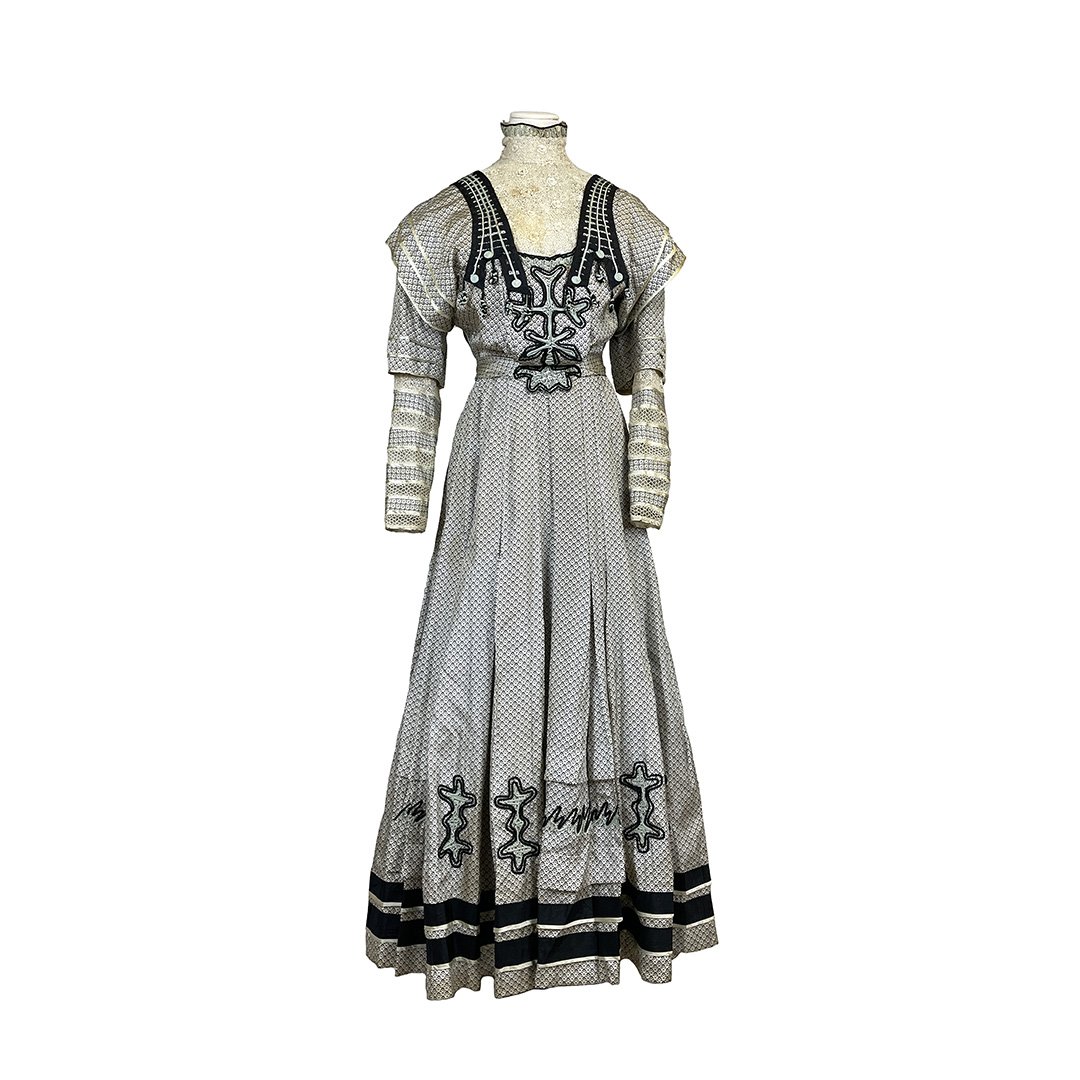Clothing & Textiles
Flapper Dress, 1919
On December 9, 1919, Eleanor Sharp Hopson Dawson wore this beaded flapper dress to Governor Edwin Morrow’s inaugural ball in Frankfort, Kentucky, right at the beginning of the decade that has become known for its iconic flappers.
Famous for Prohibition and lively parties, the 1920s was a time of dapper pin-striped suits, feathers and fedoras, and, of course, the flapper dress. The term “flapper” has evolved in meaning over the past few centuries, but by the 1920s was used to describe young women who pushed against tradition and societal expectations by wearing their hair down in a bob in addition to shorter dresses.
Flapper dresses also drew upon the jazz age culture of dancing and lively music and essentially served as a visual representation for the spirit of spontaneity, sexual liberation, and independence that followed the combined trauma of the Great War and influenza epidemic.
Ivory Day Dress, 1905
One of Madame Glover’s later creations, this ivory day dress features eyelet embroidery and a pigeon-breast style bodice. This dress belonged to Mrs. Ethel Bernheim Haas (1896-1971), the daughter of philanthropist and distiller Bernard Bernheim.
Day Dress, c. 1900
A Madame Glover creation at the height of her career, this silk day dress features a geometric pattern and crochet details. This dress belonged to Mrs. Ethel Bernheim Haas (1896-1971), the daughter of philanthropist and distiller Bernard Bernheim.
MADAME GLOVER
Madame Glover, previously Annie Casey, lived in what is now Old Louisville from the 1870s until the end of the Edwardian era. She was a talented seamstress and designer who established her own dressmaking business in Louisville. The death of her father in 1879 pushed her to look for work in local stores, such as Close & Wasson and Sharpe & Middleton, where her dressmaking began to attract attention.
After her marriage to businessman Walter E. Glover in 1886, she was able to open her first dress shop on South Fourth Street by 1891. For the next two decades, Madame Glover was a sensation. Her dress shop in the no-longer-standing Tyler Building (now the site of the Kentucky International Convention Center) catered to the needs for all sorts of society events, including debutante balls and weddings. Glover was particularly known for her bridal gowns and wedding trousseaux that contained garments a woman would need as she entered marriage.
Louisville was a fashion center between 1890 and 1915 due to dressmakers such as Madame Glover, whose creations were sought by fashionable women in town and across the country. A frequent traveler, she brought the latest styles of New York and Paris to Louisville having studied current trends and techniques, but had her own knack for beautiful styles and fabrics.
Her elegant creations are a noteworthy page in the book of Gilded Age fashion, her success built upon years of hard work and talent. Glover retired to New York after the death of her husband in 1912, but her contribution to Louisville is undeniable.
Quilted Bedcover, 1860-1864
Mary Cunningham of Danville, Kentucky made this quilted bedcover in 1860-1864 that features a triple tulip design on white cotton applique squares. The edges are bound and piped with red and green cotton.
Bedcovers, or coverlets, are fabric coverings for the outer layer of a bed that were typically woven and popular in colonial America until the mid 19th century. Quilting would have been a common pastime for women who settled in Kentucky, not only to pass down traditions, but also as a result of a largely self-sufficient, isolated frontier.
While Mary Cunningham could have crafted this quilt for herself or family, but during the Civil War many quilts provided soldiers with warm bedding or were sold to raise money for the war.
This quilt likely came into the museum collection for its direct connection to Kentucky art and craft.
Union Army Uniform, c. 1861
The sack coat and trousers you see here, along with the canvas haversack and leather belt, illustrate the typical uniform of a Union-enlisted soldier during the Civil War. Issued to Orrin E. Skinner of the 21st Massachusetts Volunteer Infantry, this kind of coat is among the rarest of Civil War uniform items one can find today because of their continued use as daily work clothing by soldiers in the post-war period. Most surviving enlisted uniforms are non-issued surplus and therefore not linked to a specific soldier.
You can see this uniform on display as an example of Union soldier attire in The Commonwealth: Divided We Fall.





